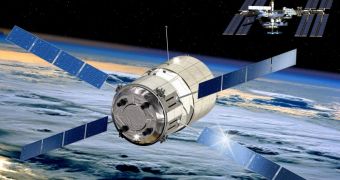After being lifted up into space with the help of the Ariane 5 space rocket, the Jules Verne Automated Transfer Vehicle detached itself from the launch vehicle and started its race towards the International Space Station. However, what was called by the European Space Agency a flawless launch proved to be anything but that, as during maneuvers in space the ATV seems to have suffered a small glitch in the navigation systems.
As soon as the thrusters were fired, the electronic unit controlling the flow of fuel and oxidizer through the four propulsion chains of the ATV detected an anomalous difference in pressure between two of the pipes that deliver the fuel from the tank to the thrusters. The 'propulsion chains' represent the valves which regulate the flow of fuel through the respective pipes. It is not yet clear what determined the glitch, as the ESA has refused so far to reveal the cause, however it is most likely linked to the electronic unit.
To compensate for the irregular flow of fuel between the two pipes, the electronic unit rerouted some of the propellant to the other three chains, after which it suddenly shut down, suggesting a possible problem with the electronic systems. After working franticly through the night, the ESA engineers finally restarted the electronic unit on-board the ATV, said ESA ATV program manager John Ellwood during the press conference which took place after the launch. "All systems are working perfectly ever since."
To restart the electronics unit, ESA engineers had to conduct a series of tests at the ATV builder, EADS Astrium, France, to reconfigure the system from the ground. Yesterday, Jules Verne had to execute a series of maneuvers to place itself in a closer orbit in order to rendezvous with the International Space Station "We're not in a situation where the mission is in danger; what we are is one step closer to that situation," said Alan Thirkettle, ISS program manager.
The ESA knew even before solving the glitch that the ATV was capable to maneuver itself with only three thrusters, thus the mission was never in danger of failing. Jules Verne was launched on Sunday (March 9th) from the Kourou spaceport in the French Guiana, and will be used from now on as primary supply vessel for the ISS, until in 2010 when the U.S. space shuttle will be retired.

 14 DAY TRIAL //
14 DAY TRIAL //